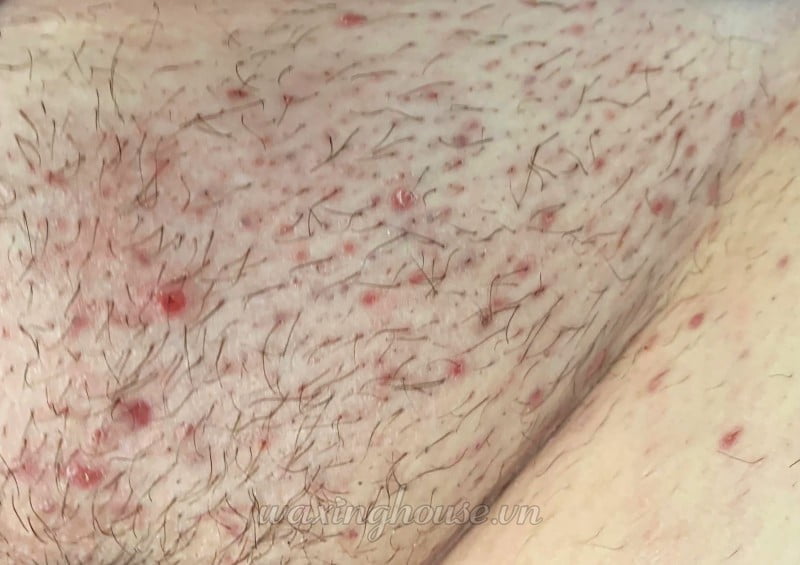Ingrown Hair – Causes and How to Treat It

Ingrown hair is one of the most common and annoying skin problems, appearing as red bumps, itchiness, or even pustules, which ruin the smooth appearance of the skin. This condition occurs when a hair curls back or grows sideways into the skin instead of straight out.
This article will help you thoroughly understand the causes of ingrown hair and the effective ways to treat it to regain your skin’s confidence.

Main Causes of Ingrown Hair
To solve the problem, we first need to know why it happens. Here are the top culprits for ingrown hair, compiled from scientific research.
1. Improper Hair Removal
- Shaving frequently can create sharp-tipped hair that easily pierces the skin and grows back into it.
- Incorrect waxing techniques can break the hair below the skin’s surface.
- Using tweezers can damage the hair follicle, leading to inflammation and blockage.
Source: Mayo Clinic, American Academy of Dermatology (AAD)
2. Clogged Hair Follicles
Dead skin cells, excess oil, and cosmetic residue can build up and clog hair follicles, causing the hair to get trapped and unable to grow straight.
3. Hair Structure and Skin Type
An individual’s genetic makeup also significantly affects the risk of ingrown hair.
- Hair Structure: People with thick, curly, or coarse hair are at a higher risk. This is common in the beard area for men and the bikini area for women.
- Skin Type: Thick or rough skin can also act as a barrier, making it harder for new hair to penetrate the epidermis.

Source: Cleveland Clinic, Journal of Dermatological Treatment
4. Wearing Tight Clothing or Frequent Friction
Tight clothing made of stiff or non-breathable materials constantly rubs against the skin, especially in areas like the bikini line, underarms, or calves. This friction not only causes irritation but also forces the hair to grow in the wrong direction, bending and curling under the skin.

5. Hormonal Imbalances or Internal Factors
In some cases, the cause can be internal. Hormonal imbalances (such as an increase in androgen hormones) can cause hair to grow faster, thicker, and coarser. Additionally, certain medications can alter hair texture and contribute to the occurrence of ingrown hair.
How to Treat Ingrown Hair Effectively
Once the cause is identified, treatment becomes simpler. Consistently apply the following methods to improve your skin.
1. Exfoliate Regularly
This is a crucial step to treat and prevent ingrown hair. Exfoliation helps remove the layer of dead skin cells, clearing the pores and paving the way for hair to grow out naturally.
- Frequency: Maintain a routine of 1-2 times per week.
- Timing: Start about 5-7 days after waxing or laser hair removal to allow the skin time to recover.
- Products: Prioritize non-abrasive gel exfoliants to avoid harsh scrubbing that can damage the skin and pores.
2. Keep Your Skin Well-Moisturized
Well-moisturized skin is softer and more elastic, which helps reduce friction and allows hair to grow more easily. Use lightweight lotions or creams that don’t clog pores after showering.
3. Choose a Suitable Hair Removal Method
If you frequently get ingrown hair after shaving or plucking, consider switching to other methods:
- Proper Waxing: Using waxing services at a reputable place with well-trained technicians and quality products will help minimize the risk of hair breakage or clogged pores after waxing.
- Laser Hair Removal: Technologies like 4-wavelength Diode Laser or New E-light not only help remove hair but also support the improvement of ingrown hair and folliculitis.
- Absolutely do not use tweezers to pick, dig at, or squeeze inflamed ingrown hair. This can cause a more severe infection and lead to hard-to-fade scars.
- If a bump is very swollen, painful, or has pus, consult a dermatologist.
How to Prevent Ingrown Hair from Coming Back
✔ Maintain a weekly routine of exfoliating and moisturizing.
✔ Wear loose, breathable clothing, especially after hair removal.
✔ Use specialized, non-clogging aftercare products post-waxing/laser.
✔ Avoid applying heavy oils or greasy products to freshly treated skin.
Final Words
Ingrown hair is a treatable skin condition if you understand the causes and consistently apply the right care measures. Maintaining a scientific skincare routine will not only solve the immediate problem but also prevent it from returning, giving you back your smooth, healthy skin.
💬 If you need more advice about your skin condition or suitable treatments, the team of experts at Waxing House is always ready to help!
Frequently Asked Questions (FAQ)
1. Does ingrown hair go away on its own?
In many cases, minor ingrown hair can resolve on its own as the hair finds its way out or is naturally shed by the body. However, without proper care, it can lead to inflammation, infection, and dark spots.
2. Should I use tweezers to remove an ingrown hair?
You should absolutely not use tweezers or sharp objects to pick or squeeze an ingrown hair. This action can easily damage the skin, cause infection, worsen the condition, and even lead to permanent scarring. Instead, it’s better to visit a reputable place with experience in handling ingrown hair (like Waxing House), as technicians know how to effectively remove it with minimal damage to the skin or follicles.
3. Does exfoliating make ingrown hair worse?
On the contrary, proper exfoliation is an effective method to prevent and improve ingrown hair. However, you should avoid scrubbing too hard and not exfoliate over inflamed, swollen, or red bumps. Exfoliants with large granules can damage pores and cause the ingrown hair spots to darken. It is recommended to use a gel-based exfoliant without granules, once a week.
4. When should I see a specialist?
If the ingrown hair bumps are severely inflamed, swollen, painful, contain pus, or recur continuously despite at-home care, you should see a dermatologist.


 Tiếng Việt
Tiếng Việt